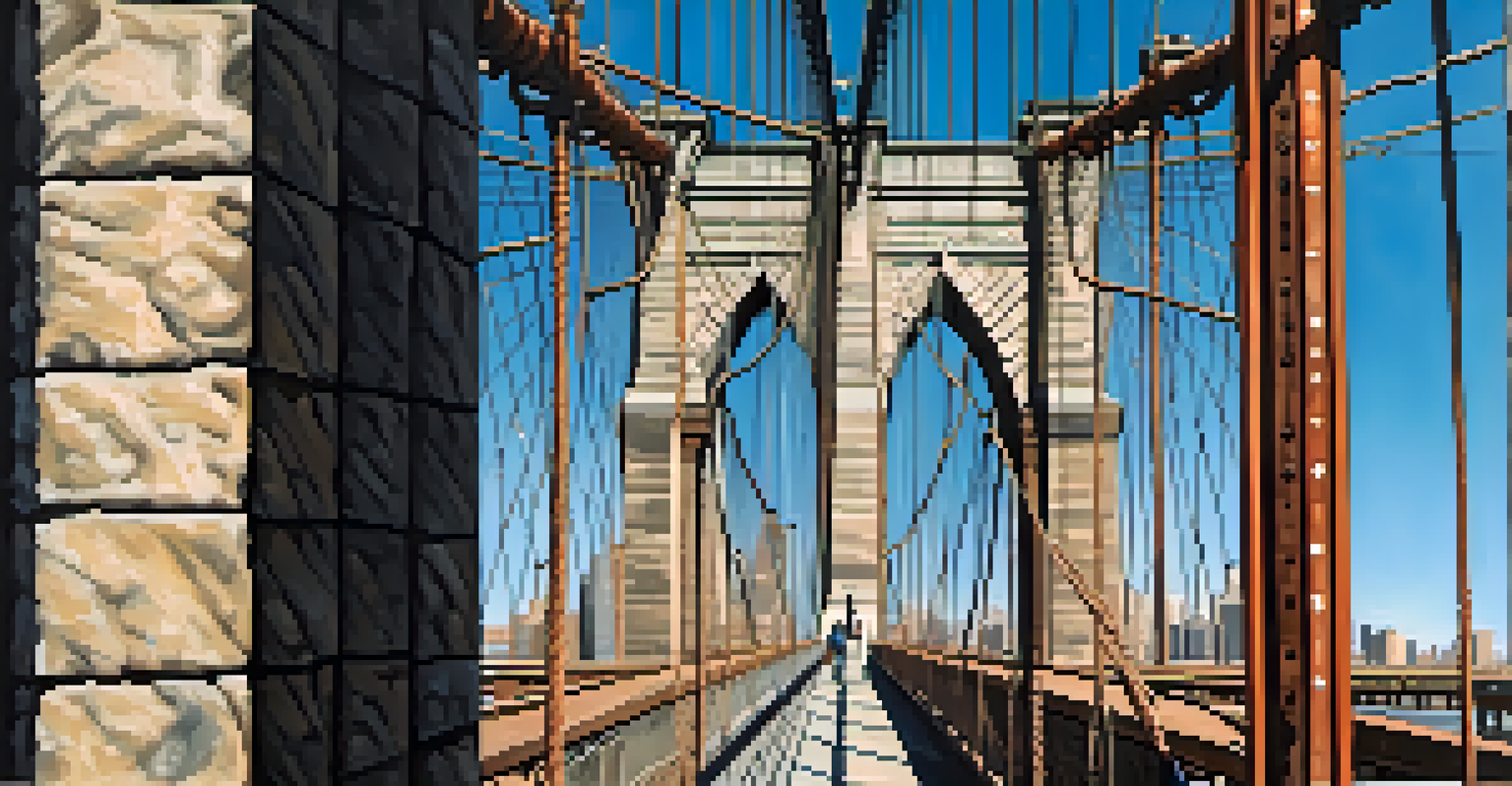The Legacy of the Brooklyn Bridge in NYC Transport History

The Vision Behind the Brooklyn Bridge's Construction
The Brooklyn Bridge, completed in 1883, was a groundbreaking project that embodied the vision of connecting Brooklyn and Manhattan. Designed by John A. Roebling, the bridge was the first steel-wire suspension bridge, showcasing innovative engineering techniques of its time. The project faced numerous challenges, including political opposition and financial constraints, yet it became a symbol of progress and ambition.
The Brooklyn Bridge is a splendid piece of engineering that has inspired awe and admiration from millions of people around the world.
Roebling's vision was not only to create a functional crossing but to inspire a sense of unity among the boroughs. The bridge was initially intended for horse-drawn carriages and pedestrians, reflecting the transportation needs of the 19th century. However, it quickly evolved into a vital artery for emerging transportation modes, setting a precedent for future infrastructure projects.
The completion of the Brooklyn Bridge marked a significant moment in urban planning, illustrating how infrastructure could transform city dynamics. By bridging two bustling areas, it facilitated commerce, travel, and cultural exchange in ways previously unimagined. This foundational vision laid the groundwork for future urban transport developments.
Engineering Marvel: The Construction Techniques Used
The construction of the Brooklyn Bridge was a feat of engineering that utilized cutting-edge techniques for its time. The use of steel cables, which were revolutionary in the late 19th century, allowed for a stronger and more resilient structure. John A. Roebling’s innovative ideas, combined with the work of his son, Washington Roebling, pushed the boundaries of bridge construction.

One notable challenge was the underwater caissons, which were essential for anchoring the bridge's towers. Workers faced the danger of 'caisson disease', now known as decompression sickness, while building these underwater chambers. Despite these hardships, the dedication and ingenuity of the workforce ensured the project stayed on track.
Engineering Innovation Redefined
The Brooklyn Bridge showcased groundbreaking engineering techniques, including steel-wire suspension and underwater caissons, setting a standard for future infrastructure projects.
The successful completion of the Brooklyn Bridge not only demonstrated engineering prowess but also inspired future infrastructure projects worldwide. It became a model for bridge design, showing how creativity and practicality could merge to solve complex urban transport challenges. This legacy continues to influence modern engineering practices today.
Transforming Transportation in New York City
Upon its opening, the Brooklyn Bridge revolutionized transportation in New York City. It provided a direct route between Brooklyn and Manhattan, significantly reducing travel times for commuters and goods. This connectivity boosted economic growth and encouraged population shifts, as people flocked to the suburbs of Brooklyn.
The bridge is a symbol of the great American spirit, a testament to the resilience and ingenuity of those who built it.
Before the bridge, ferry services were the primary means of crossing the East River. The new bridge made it easier for residents to commute, leading to an increase in the number of people living in Brooklyn while working in Manhattan. This shift changed the demographic landscape, creating a more interconnected urban environment.
The Brooklyn Bridge also paved the way for future transportation innovations, such as the subway system. As the city expanded, the demand for efficient transport solutions grew, leading to developments that can be traced back to the bridge's influence. Today, it remains a vital part of NYC's transport network, reflecting its lasting impact on urban mobility.
Cultural Icon: The Bridge in Art and Literature
Beyond its practical uses, the Brooklyn Bridge has become a cultural icon, inspiring countless artists, writers, and musicians. It has been depicted in paintings, photographs, and films, symbolizing the spirit of New York City. The bridge's stunning Gothic towers and sweeping views of the skyline make it a favorite subject for photographers and creators alike.
In literature, the Brooklyn Bridge has served as a metaphor for connection and resilience. Authors have used its imagery to explore themes of unity, struggle, and the human experience in the bustling metropolis. This cultural significance reinforces the bridge’s role as more than just a transport link; it embodies the aspirations and dreams of millions.
Cultural and Economic Transformation
By connecting Brooklyn and Manhattan, the bridge revolutionized transportation, boosted economic growth, and became a lasting cultural icon for New York City.
The bridge's presence in popular culture continues to grow, with events like the annual Brooklyn Bridge Walk attracting thousands. This celebration of the bridge's legacy brings people together, reflecting its role as a shared space in the community. As a cultural landmark, the Brooklyn Bridge endures as a testament to both engineering triumph and artistic inspiration.
Challenges and Preservation Efforts Over Time
Throughout its history, the Brooklyn Bridge has faced various challenges, including environmental wear and tear, traffic congestion, and the need for maintenance. As one of New York City's most iconic structures, ensuring its integrity has been a priority for city officials. Preservation efforts have included regular inspections and renovations to address structural concerns.
In recent years, increasing pedestrian and vehicle traffic has added strain to the bridge. To accommodate this, initiatives have been implemented to enhance safety and accessibility for all users. Upgrades to the pedestrian walkway and improvements in traffic management reflect ongoing efforts to balance the needs of commuters and tourists.
These preservation endeavors underscore the bridge's enduring legacy, ensuring it remains a vital part of the city's infrastructure. By investing in its future, New York City honors the vision of its creators while adapting to contemporary needs. This commitment to preservation helps maintain the bridge as a symbol of resilience and innovation.
The Economic Impact of the Brooklyn Bridge
The Brooklyn Bridge has had a profound economic impact on both Brooklyn and Manhattan, facilitating trade and commerce between the two boroughs. By streamlining transportation, it enabled businesses to thrive by improving access to markets and resources. The bridge played a crucial role in the economic development of Brooklyn, attracting industries and residents alike.
As a key transport link, the bridge has also contributed to tourism, drawing millions of visitors each year. Tourists flock to the bridge to experience its stunning views and rich history, which brings vital revenue to local businesses and cultural institutions. This influx of visitors reinforces the bridge's status as an integral part of New York City's economy.
Ongoing Preservation Efforts
As a vital part of New York City's infrastructure, continuous maintenance and preservation initiatives ensure the Brooklyn Bridge remains safe and functional for future generations.
The economic benefits extend beyond immediate financial gains; the bridge has fostered long-term growth and stability in the region. Its influence on urban development patterns has created opportunities for new businesses and revitalization projects, ensuring that the legacy of the Brooklyn Bridge continues to shape the city's economic landscape for generations to come.
Looking Forward: The Future of the Brooklyn Bridge
As we look to the future, the Brooklyn Bridge remains a critical component of New York City's transport network. With ongoing advancements in technology and changes in urban mobility, the bridge will continue to adapt to meet the needs of its users. Plans for future upgrades and maintenance will ensure it remains safe and accessible for generations to come.
Emerging trends, such as electric vehicles and increased focus on sustainability, present new opportunities for the bridge's evolution. Incorporating eco-friendly practices into its maintenance and operations can further enhance its legacy as a symbol of innovation. Community engagement will play a vital role in these discussions, ensuring that the bridge serves the public interest.

Ultimately, the Brooklyn Bridge is more than just a physical structure; it embodies the spirit of New York City. Its legacy will continue to inspire future generations, reminding us of the power of connection and collaboration. As we embrace the future, the Brooklyn Bridge will undoubtedly remain a cherished landmark, representing both history and progress.